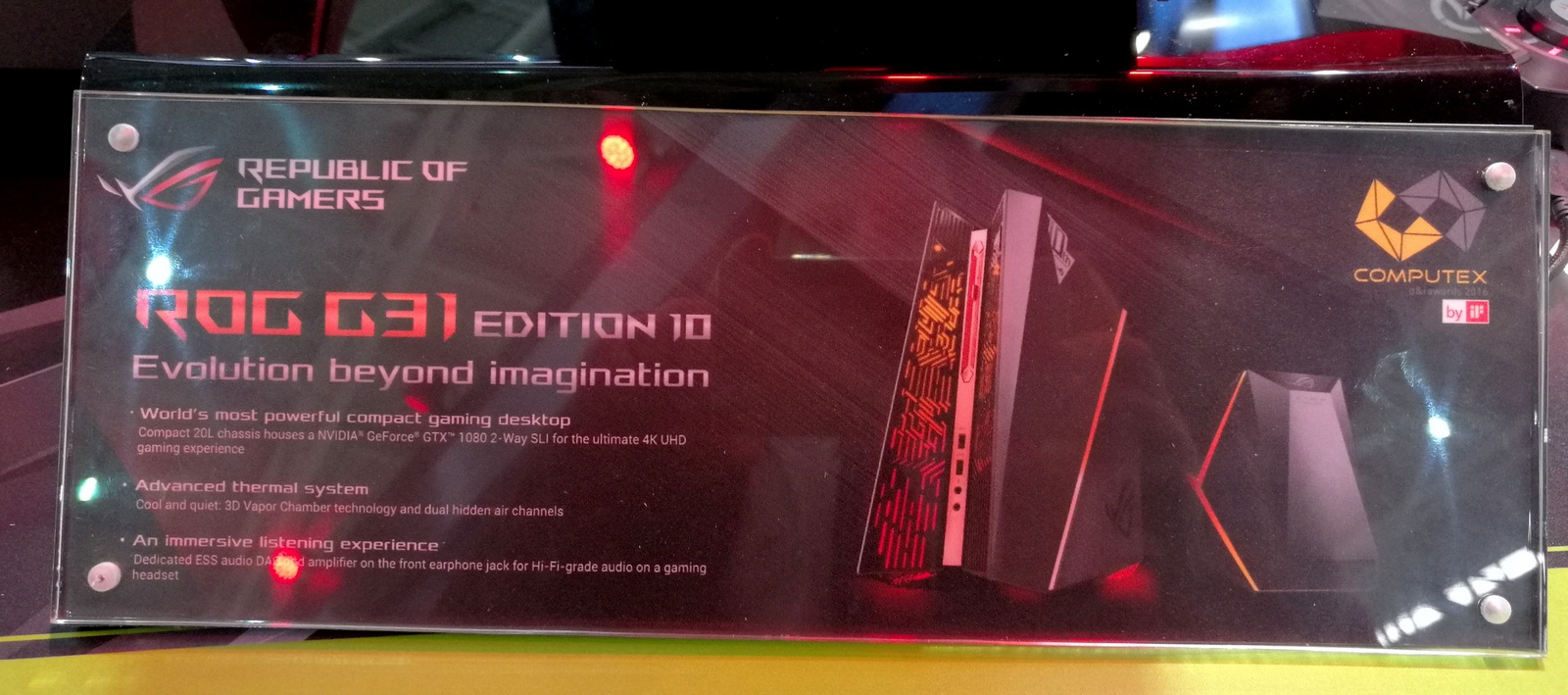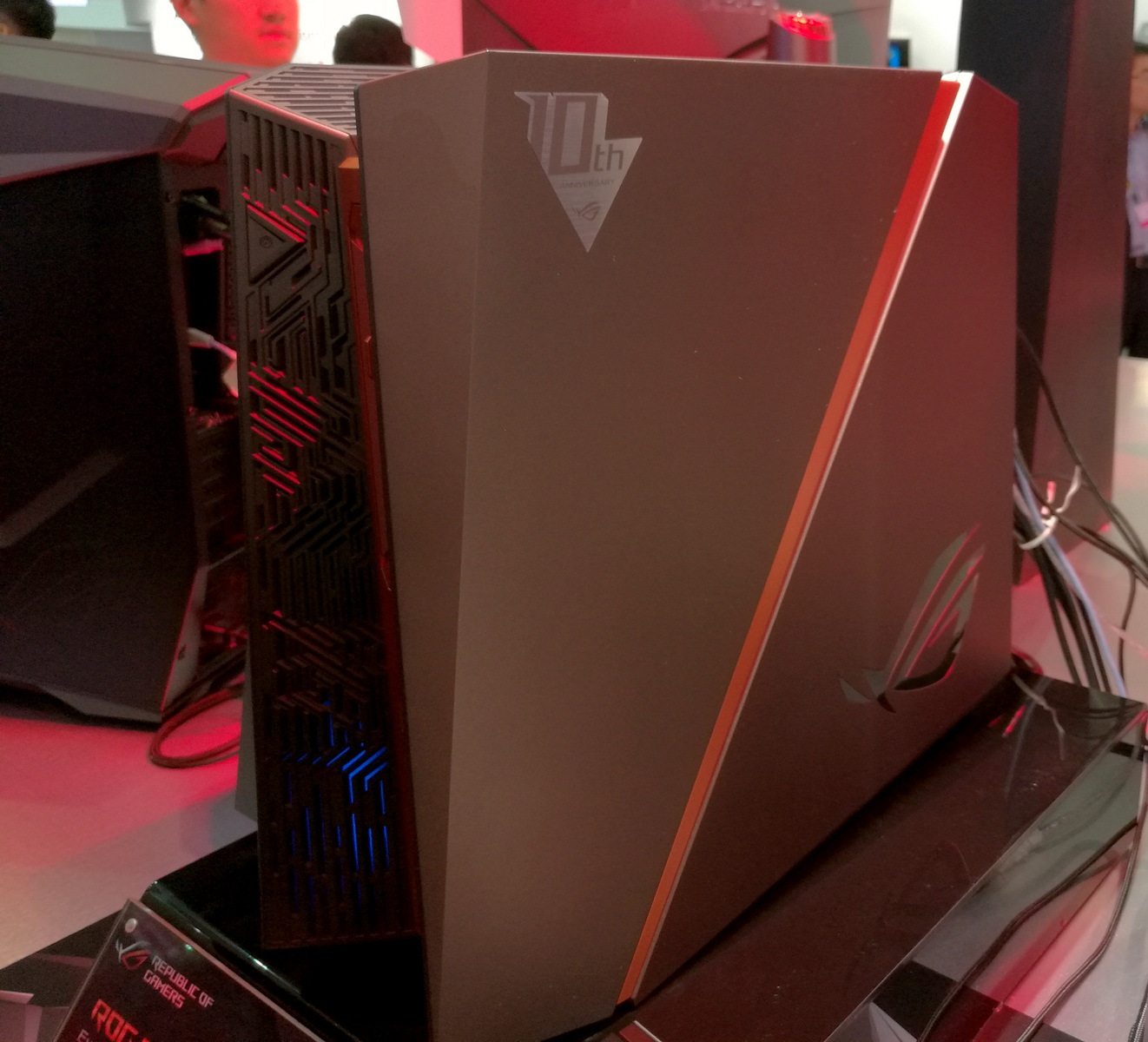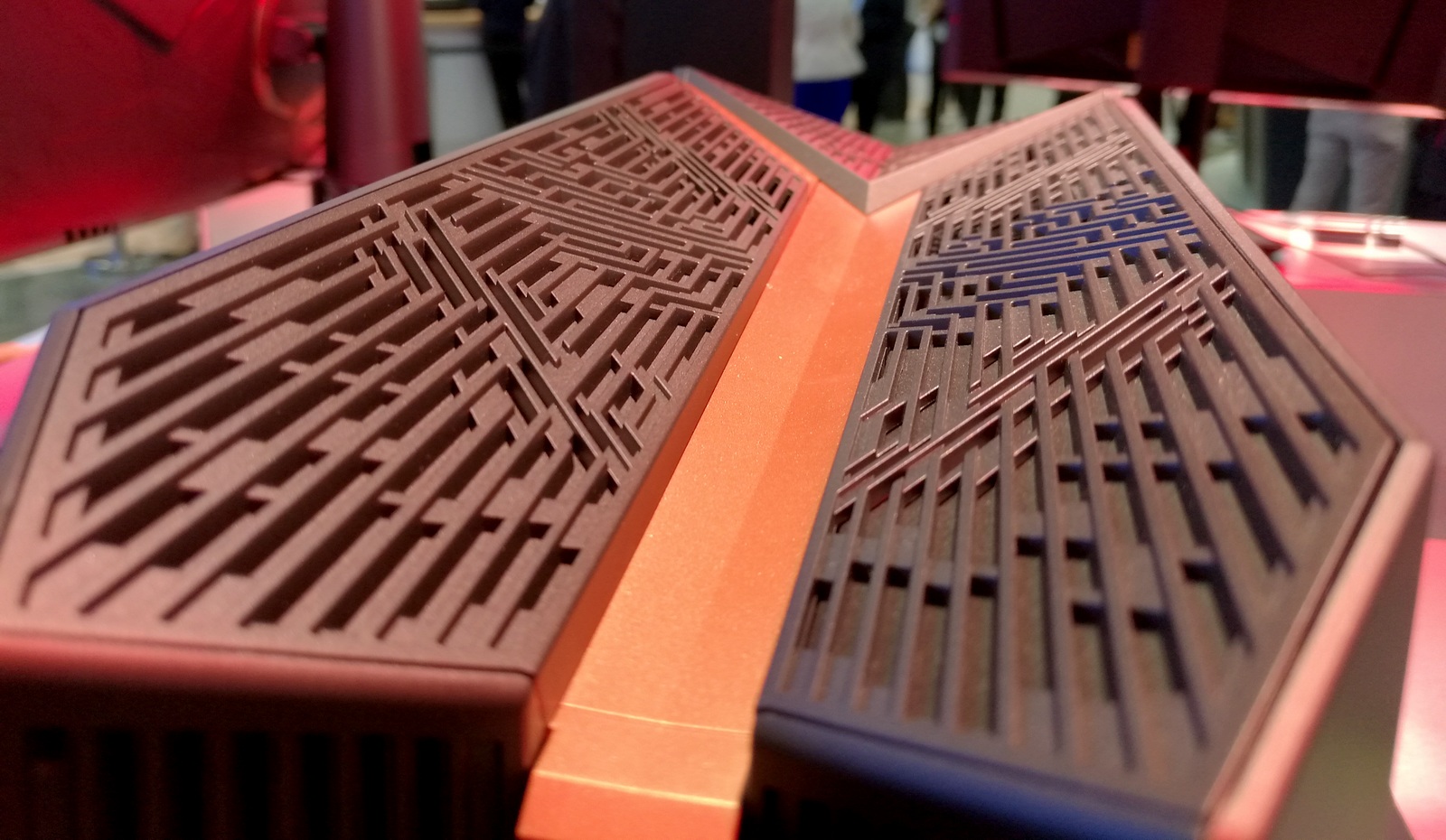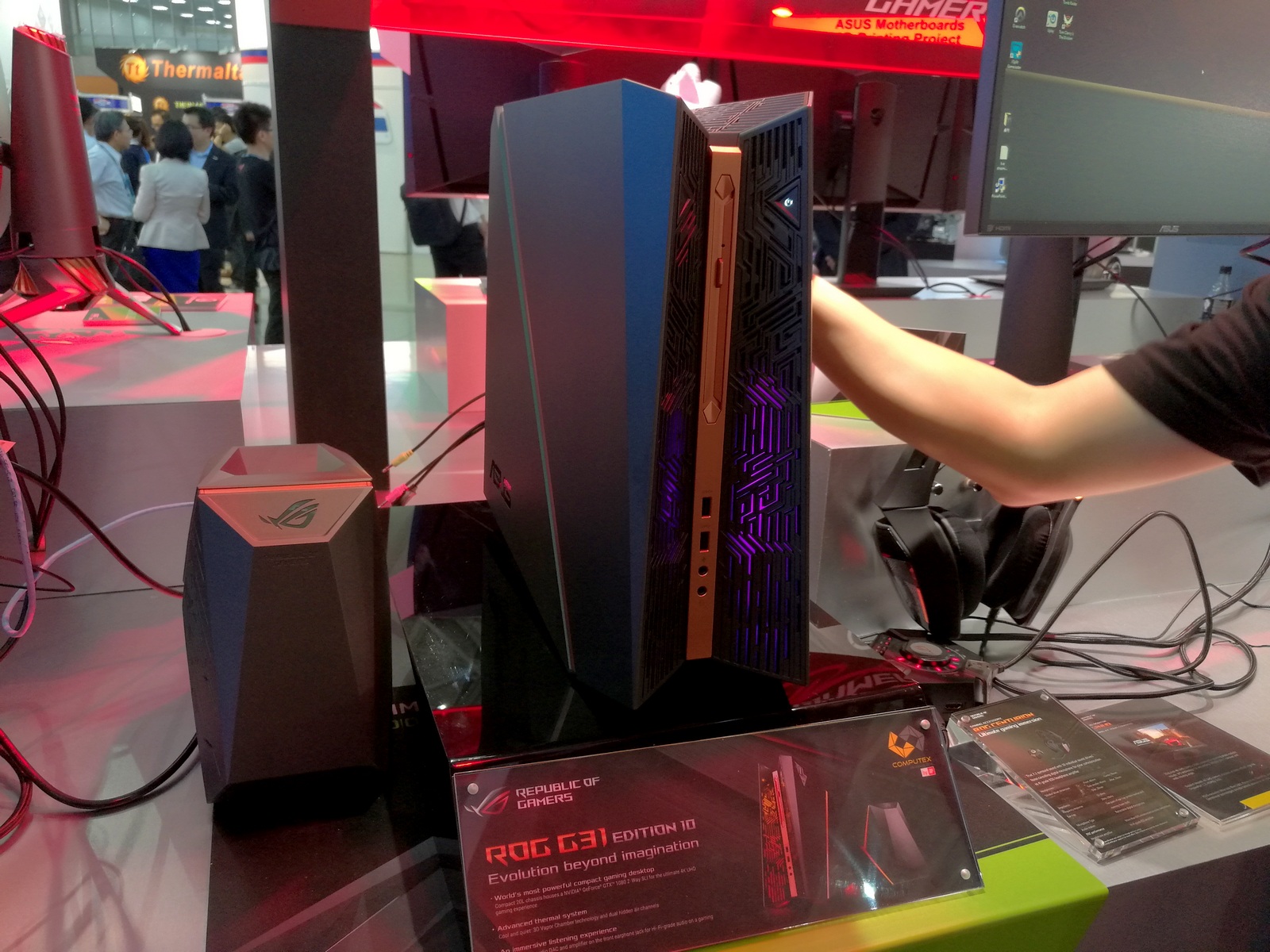ASUS at Computex 2016: The 10 Years of the Republic Of Gamers (ROG) Booth Tour
by Ian Cutress on June 22, 2016 8:00 AM ESTDesktops: ROG G31
Moving from something completely custom in the Avalon to something we’ve seen before, but upgraded. The new G31 Edition 10 is an upgraded version of the G20, a gaming desktop PC that ASUS announced last year under their Mayan-style design strategy that also included the small book-sized GR8 desktop. The G20 aimed at the crowd that wanted a different style of desktop/gaming machine, with a different look but everything pretty much integrated in a design that aimed to adjust the airflow for such a large amount of power. The G31 by comparison doubles up the number of GPUs and equips the system with the latest processors and memory.
The Edition 10 version of the G31, designed for the ROG 10-Year, will be the fully upgraded model with a 10-Year sticker on the side. This edition will house a full Core i7 (most likely the i7-6700/K), two full GTX 1080s in SLI, the Z170 chipset, support for four DDR4 memory modules and 64 GB (it’s not mentioned if they are SO-DIMM or regular), and at least two M.2 PCIe 3.0 x4 slots capable of RAID-0. To top it off, the optical disk drive at the front is also a Blu-Ray writer/DVD writer as well.
For the Edition 10, all the LEDs are RGB and additional LEDs are placed down the side stripe as well.
Being under the red lights on the show made it a bit difficult to see the LEDs, but the full chassis comes in at a 20L volume. If we compare that to the recent review of the NZKT Manta mini-ITX case from Tracy which comes in at 47L, we can see the benefits of going custom in something like this – the full motherboard and GPUs are custom for the design and are arranged to use the cooling system as efficient as possible.
Typically a PC chassis has the power supply bundled inside, however to fit this shape and design ASUS are going with an external power supply. We weren’t given an exact rating, but if we give a generous budget of 100W for the CPU, 200W each for the GPUs, 100W for everything else and then an extra 20%, then it’s probably around 720W.
No words as to pricing or release dates as of yet, but the high end ROG G20 with an i7-4790, 16GB of DRAM, a single GTX 745 and a 1TB SSD is currently retailing on Amazon for $1360. I would expect the high edition ROG G31, with dual GTX 1080 GPUs and 64GB of memory, to be nearer $4000. Of course, something like the MSI Vortex (which uses mobile GPU variants of GTX 960/970) is the competition here, and the high end version of that is $4000 as well.















43 Comments
View All Comments
A5 - Wednesday, June 22, 2016 - link
End users who are buying Broadwell-E are almost always doing it for 3+ way SLI reasons, which pretty much forces you into full ATX.They presumably have research (or data from the past) that says they will not sell enough mATX boards with HEDT chipsets to be worth the engineering effort.
Bragabondio - Wednesday, June 22, 2016 - link
Well now that Nvidia would not support more than 2 cards SLI (except for benchmarking applications) the argument for 3 way SLI becomes moot. (micro ATX supports 2 way SLI). Starting to think we will be stuck with 4 core CPUs for the next 5+ years unless ZEN is a huge success.Sushisamurai - Wednesday, June 22, 2016 - link
uhhh... Nvidia still has 3 way/4 way SLI - they've only restricted SLI requirements to PCIe x8, versus AMD's crossfire x4; presumably to maintain a performance target. With "consumer" lines of Intel CPU's, you only get max 20 PCIe lanes (correct me if I'm wrong), allowing only 2 way SLI. HEDT chips have 28 to 40 to 40. Hence, 3 way to 4 way SLI is pretty much restricted purely to HEDT. Anandtech had an article about CPU/PCIe bottleneck with SLI/CF a ?few years back. If memory serves me correctly, PCIe x4 bottlenecks modern high end GPU's, and an i5 can run 2 high end GPU's without bottlenecking - it is when you go 3 cards you'll need an i7 for gaming (assuming you have enough lanes), and HEDT (my opinion now) if you want 4 cards (due to PCIe lanes, and enough cores to feed the cards)Bragabondio - Wednesday, June 22, 2016 - link
Correct until GTX 1070&1080 were introduced. Starting with the GeForce GTX 1080, Nvidia is discontinuing official support for 3-way and 4-way multi-GPU SLI setups.http://www.pcworld.com/article/3071332/hardware/it...
Sushisamurai - Thursday, June 23, 2016 - link
Oh that is messed up. I've read their white paper, didn't even know they trashed the enthusiast key option. Wow that's super unfortunate.alphasquadron - Wednesday, June 22, 2016 - link
"So I don't understand why manufacturers don't want my money?"I think they do but as stated in the article:
"The three major form factors for custom build personal computers, in order of popularity, are ATX, followed by micro-ATX and then mini-ITX."
I too am waiting for an external dock that I can plug my laptop into and achieve 80-90% of performance of a full size desktop. Whoever makes this will have grabbed two markets. Those who want a gaming desktop and are okay with huge cases (usually younger) and professionals like me who want the same but would never get a gigantic case. If we can get an external dock that tries to be compatible with most laptops as much as possible without looking like an eyesore and can deliver close to desktop performance, it would be an instant buy for a lot of people. As you now have a laptop and desktop. Though I think that this would come from a laptop manufacturer as if it was very well made and successful, I would think the market that would buy a desktop over a laptop for 10% gain in performance would be very small.
Bragabondio - Wednesday, June 22, 2016 - link
Guess I have to give my dream for small but super powerful desktop PC and embrace the reality that laptop/surface device + dock is the future for the middle aged professional :)Bragabondio - Wednesday, June 22, 2016 - link
One more thing. The ATX may be indeed most popular size but that is mostly due to tradition not function as 99% of the consumer market don't need/use all the slots and space of a larger ATX case. That is why I like project Avalon but nobody knows if it ever would become a reality.Ananke - Wednesday, June 22, 2016 - link
Unfortunately, in the current moment of the high tech industry, "middle age" is very inappropriate. Companies think their teen- and twenty-year old customers have many thousands of disposable income , and cater to them exclusively. Besides, young people buy easily obsolete or inferior tech, since they don't have comparison base :):). The only problem for the tech industry is, that younger population usually has no disposable income /and that's kinda universal truth over many centuries/ and just doesn't buy because it can't pay.Bragabondio - Wednesday, June 22, 2016 - link
well said Ananke! Plus, as a coup de grace now we have to deal with gazillion of RGB lights inside our cases - if I wanted a freaking X-mas tree inside my case I would have bought one ! :)